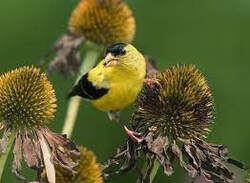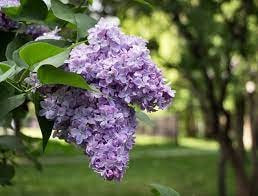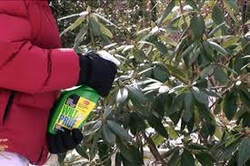|
Another growing season has come and gone, and it is time to prepare your garden for winter. Spending just a little time in the garden this fall will make for a healthy and happy spring garden.  Perennials The first task most gardeners consider when preparing the garden for winter is cutting back perennials. While cutting everything to the ground may give the garden a tidy look, it does a disservice to wildlife species that can make use of some plants in the winter. Leaving perennial seed heads provides natural foraging habitat for native wildlife. In the winter months when food is scarce, gardens full of withered fruit and dried seed heads can provide birds with a reliable food source. Seed-eating songbirds such as finches, sparrows, chickadees, juncos, and jays will make use of many common garden plants. When cleaning up the garden, prioritize removing and discarding diseased top growth, but leave healthy seed heads standing. Many perennials lose all of their top growth, but when you cut the brown or yellow stalks, you will find green, lush, healthy growth at the base of the plant. Leave the ground hugging green leaves. Examples of these types of perennials are Oenothera, Salvias, Penstemons, and Scabiosas.  Flowering Shrubs
Shrubs that bloom on old wood (current year’s wood) are typically summer and fall bloomers. Even though it may not hurt them to be prune in the fall, I usually wait to do so until spring for more winter structure in the garden. An exception to this rule are lavender, caryopteris and buddleias (butterfly bushes). These plants should be left alone in the fall. Hydrangeas are a complex category. See our blog on pruning hydrangeas.  Evergreens Do not prune evergreens in late summer or early fall. It may promote new growth that will not have time to harden off before first frost. Tender new foliage will be brown and unattractive in winter.  Anti Desiccant Sprays If your roses or broadleaf evergreens, like rhododendrons, are in an exposed spot, or if you have recently transplanted them, it is wise to spray them in late fall with Wiltpruf, an anti-desiccant spray made from pine sap. This will keep the plants from losing valuable moisture in the cold drying winter winds. Be sure your broadleaf evergreens begin winter well watered as an added extra protective measure.  Mulching There are two different mulching chores in the fall.
Enjoy the fall colors, cool crisp air and those last warm days to put your garden to rest for the winter. A few hours in the garden this fall will reap healthy, happy plants in the spring.
Comments are closed.
|
Thank you for finding us! Holly and I have collaborated to bring you informative, fun, and seasonal garden inspiration blogs.
Subscribe to receive our blogs on the 1st and 15th of the month--Gwen Follow my landscape & garden design Pinterest Page to see more pics, inspiration and Gwen's home garden journey!
AuthorsGwen Wisniewski: Landscape and Garden Designer. Contact me. Let me help you integrate these garden inspirations. Choose the links below to find out more about my landscape design service or to make an appointment. |


 RSS Feed
RSS Feed